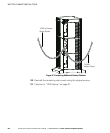
Eaton 9170
+
UPS (3–18 kVA) User's Guide S 164201393 Rev E www.eaton.com/powerquality
67
Chapter 7 UPS Startup
This section provides step-by-step instructions for starting your Eaton
9170+ system. Follow these procedures closely to avoid potential
damage to your equipment or the UPS and to protect yourself and
others from hazardous operating conditions.
C A U T I O N
S This UPS contains its own energy source (batteries). The output receptacles may carry
hazardous voltage even when the UPS is not connected to an AC supply. When AC input
voltage is present, the Eaton 9170+ system can provide output voltage even though its
batteries are disconnected. To confirm that there is no UPS output voltage, always
disconnect all of the AC input sources and unplug all strings of internal battery modules;
if the UPS has one or more separate battery cabinets, open (push in) the DC disconnect
switch button on each battery cabinet or unplug all battery strings in each battery
cabinet.
S To reduce the risk of fire or electric shock, install this UPS in a temperature and humidity
controlled, indoor environment, free of conductive contaminants. Ambient temperature
must not exceed 40°C (104°F). Do not operate near water or excessive humidity (95%
maximum).
S For optimum battery life, ambient temperature should not exceed 25°C (77°F). Battery
life is substantially reduced if ambient temperature is higher.
Power and Battery Module Installation
To install the power and battery modules into the Eaton 9170+ cabinet:
1. Remove the front cover(s) of the cabinet.
The covers have spring latches on the left and right sides that hold
them in place.
NOTE Place battery modules below all power modules in the UPS cabinet. Two battery
modules (side-by-side) are required to complete each battery string.
2. Insert the battery modules into the cabinet.
Push each module firmly until the front latch snaps to secure the
battery module (see Figure 48). Repeat for each additional battery
module.


















